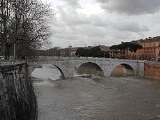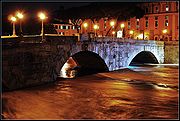
Pons Cestius
Encyclopedia
The Pons Cestius is a Roman stone bridge
in Rome
, Italy
, spanning the Tiber
to the west of the Tiber Island
. The original version of this bridge was built around the 1st century BC (some time between 62 and 27 BC), after the Pons Fabricius
, sited on the other side of island. Both the ponti Cestius and Fabricius were long-living bridges; however, whereas the Fabricius remains wholly intact, the Ponte Cestio was partly dismantled in the 19th century, with only some of the ancient structure preserved.
The Pons Cestius is the first bridge that reached the right bank of Tiber from the Tiber Island. Whereas the island was long connected with the left bank of the Tiber and the heart of ancient Rome
, even before the pons Fabricius, the right bank (Transtiber) remained unconnected until the Cestius was constructed. Several prominent members of the Cestii clan from the 1st century BC are known, but it is uncertain which of them built this bridge.
 In the 4th century the Pons Cestius was rebuilt by the Emperors Valentinian I
In the 4th century the Pons Cestius was rebuilt by the Emperors Valentinian I
, Valens
and Gratian
and re-dedicated in 370 as the Pons Gratiani. The bridge was rebuilt using tuff
and peperino
, with a facing of travertine
. Some of the rebuilding material came from the demolished porticus of the nearby Theatre of Marcellus
.
During the building of the walls along the river embankment in 1888–1892, the bridge had to be demolished and rebuilt, as the western channel was widened from 48 to 76 meters. The ancient bridge, which had two small arches, was simply not long enough. A new bridge, with three large arches, was constructed in its stead, with its central arch reusing about two-thirds of the original material.
Roman bridge
Roman bridges, built by ancient Romans, were the first large and lasting bridges built. Roman bridges were built with stone and had the arch as its basic structure....
in Rome
Rome
Rome is the capital of Italy and the country's largest and most populated city and comune, with over 2.7 million residents in . The city is located in the central-western portion of the Italian Peninsula, on the Tiber River within the Lazio region of Italy.Rome's history spans two and a half...
, Italy
Italy
Italy , officially the Italian Republic languages]] under the European Charter for Regional or Minority Languages. In each of these, Italy's official name is as follows:;;;;;;;;), is a unitary parliamentary republic in South-Central Europe. To the north it borders France, Switzerland, Austria and...
, spanning the Tiber
Tiber
The Tiber is the third-longest river in Italy, rising in the Apennine Mountains in Emilia-Romagna and flowing through Umbria and Lazio to the Tyrrhenian Sea. It drains a basin estimated at...
to the west of the Tiber Island
Tiber Island
The Tiber Island , is a boat-shaped island which has long been associated with healing. It is an ait, and is one of the two islands in the Tiber river, which runs through Rome; the other one, much larger, is near the mouth. The island is located in the southern bend of the Tiber. It is...
. The original version of this bridge was built around the 1st century BC (some time between 62 and 27 BC), after the Pons Fabricius
Pons Fabricius
The Pons Fabricius or Ponte dei Quattro Capi, is the oldest Roman bridge in Rome, Italy, still existing in its original state. Built in 62 BC, it spans half of the Tiber River, from the Campus Martius on the east side to Tiber Island in the middle...
, sited on the other side of island. Both the ponti Cestius and Fabricius were long-living bridges; however, whereas the Fabricius remains wholly intact, the Ponte Cestio was partly dismantled in the 19th century, with only some of the ancient structure preserved.
The Pons Cestius is the first bridge that reached the right bank of Tiber from the Tiber Island. Whereas the island was long connected with the left bank of the Tiber and the heart of ancient Rome
Ancient Rome
Ancient Rome was a thriving civilization that grew on the Italian Peninsula as early as the 8th century BC. Located along the Mediterranean Sea and centered on the city of Rome, it expanded to one of the largest empires in the ancient world....
, even before the pons Fabricius, the right bank (Transtiber) remained unconnected until the Cestius was constructed. Several prominent members of the Cestii clan from the 1st century BC are known, but it is uncertain which of them built this bridge.

Valentinian I
Valentinian I , also known as Valentinian the Great, was Roman emperor from 364 to 375. Upon becoming emperor he made his brother Valens his co-emperor, giving him rule of the eastern provinces while Valentinian retained the west....
, Valens
Valens
Valens was the Eastern Roman Emperor from 364 to 378. He was given the eastern half of the empire by his brother Valentinian I after the latter's accession to the throne...
and Gratian
Gratian
Gratian was Roman Emperor from 375 to 383.The eldest son of Valentinian I, during his youth Gratian accompanied his father on several campaigns along the Rhine and Danube frontiers. Upon the death of Valentinian in 375, Gratian's brother Valentinian II was declared emperor by his father's soldiers...
and re-dedicated in 370 as the Pons Gratiani. The bridge was rebuilt using tuff
Tuff
Tuff is a type of rock consisting of consolidated volcanic ash ejected from vents during a volcanic eruption. Tuff is sometimes called tufa, particularly when used as construction material, although tufa also refers to a quite different rock. Rock that contains greater than 50% tuff is considered...
and peperino
Peperino
Peperino is an Italian name applied to a brown or grey volcanic tuff, containing fragments of basalt and limestone, with disseminated crystals of augite, mica, magnetite, leucite, and other similar minerals...
, with a facing of travertine
Travertine
Travertine is a form of limestone deposited by mineral springs, especially hot springs. Travertine often has a fibrous or concentric appearance and exists in white, tan, and cream-colored varieties. It is formed by a process of rapid precipitation of calcium carbonate, often at the mouth of a hot...
. Some of the rebuilding material came from the demolished porticus of the nearby Theatre of Marcellus
Theatre of Marcellus
The Theatre of Marcellus is an ancient open-air theatre in Rome, Italy, built in the closing years of the Roman Republic. At the theatre, locals and visitors alike were able to watch performances of drama and song. Today its ancient edifice in the rione of Sant'Angelo, Rome, once again provides...
.
During the building of the walls along the river embankment in 1888–1892, the bridge had to be demolished and rebuilt, as the western channel was widened from 48 to 76 meters. The ancient bridge, which had two small arches, was simply not long enough. A new bridge, with three large arches, was constructed in its stead, with its central arch reusing about two-thirds of the original material.

